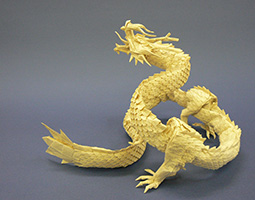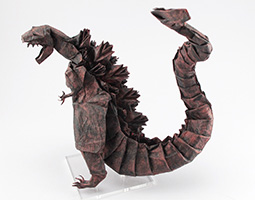INDEX
- English
- 日本語
- English
- 日本語

Wasp 2.6 is one of Kamiya’s important works. Height 5 cm; width 13 cm

Kamiya Satoshi 
Ryu-zin 3.5 is known as one of Kamiya Satoshi’s most intricate works. Height 20 cm 
Godzilla 2016 another. Height 23 cm. The work makes extensive use of irregular finishing touches that cannot be represented in pictorial folding instructions. 
Kamiya’s collected works with the author’s comments in English and Japanese
December 2021
“Super Complex” Origami

The origami works of Kamiya Satoshi are referred to as “super complex” and they have won him many fans in Japan and abroad. Kamiya, who started origami in his childhood, continues to share his super complex origami creations with the world.

Origami comes in many forms, ranging from simple shapes to abstract creations. Some origami artists create what are termed “super complex” works, and Kamiya Satoshi is a leading expert in this field. “Super complex” origami refers to intricate and sophisticated works of art fashioned from a single sheet of paper. Kamiya’s works make a strong impression on the viewer because they are so detailed that at first glance it is hard to believe they are made from a single sheet of paper. The unusually high level of detail owes to Kamiya’s desire to create the shapes he wants using origami, rather than create the shapes he can using origami. For Kamiya, the intricacy of the creation is not the goal but the result. Even when told that something is too complicated to create with origami, he continues to refine his technique, producing exquisitely detailed work.

Born in Nagoya City, Aichi Prefecture in 1981, Kamiya began origami at the age of three. His parents would often buy him origami paper and borrow children’s origami books from the local library. By the time he was ten years old, he had moved on to origami books for adults and was making quite intricate origami pieces.
Looking back on his childhood, Kamiya recalls, “Even I’m not sure when I started making super complex origami. But inspired by the works I saw in books, I began to create my own works in non-traditional origami forms. I enjoyed it and kept at it until at some point my works began to appear in books and magazines.
Kamiya shot to fame after appearing on a popular TV program called “TV Champion.” He entered the program’s Origami King Championship for the first time in 1999 at the age of 17, won the title and then retained it repeatedly, becoming a household name in Japan. From 2000, Kamiya studied in the United States for two years, where he gained valuable experience interacting with local origami artists and enthusiasts at the same time as learning English. It was in the United States, where good quality paper is hard to come by, that Kamiya once again realized the importance of paper quality for origami, learning from artists who were making their own origami paper by hand.

Some of Kamiya’s origami creations have been compiled into three volumes of his collected works, illustrated with beautiful photographs and accompanied by precise pictorial folding instructions, together with the author’s comments in both Japanese and English. These volumes are regarded by aficionados as the bible of super complex origami. In particular, Ryu-zin 3.5 (created in 2005), considered to be one of Kamiya’s most intricate creations, is a major work that took around one month to complete, using only a single sheet of paper measuring two meters on each side. Ryu-zin 3.5 is widely regarded as the one of most intricate origami pieces ever created. Overseas meanwhile, Kamiya’s creations are highly regarded as art, with one of his important works, Wasp, having once been displayed in a store window of the French luxury brand Hermès.
“The most interesting thing about origami is that the more modifications you make to a work, the more its shape changes. That’s why I enjoy the process of working with my hands, that feeling of anticipation that somehow what I’m folding will eventually turn out the way I want, more than the moment the piece I had in mind is actually completed,” says Kamiya.

It could be that no one enjoys origami as much as Kamiya.
Kamiya says there are undoubtedly still many origami shapes and modes of expression that no one has ever thought of. His mission is to constantly devise new ways of folding, expanding the possibilities of origami.

